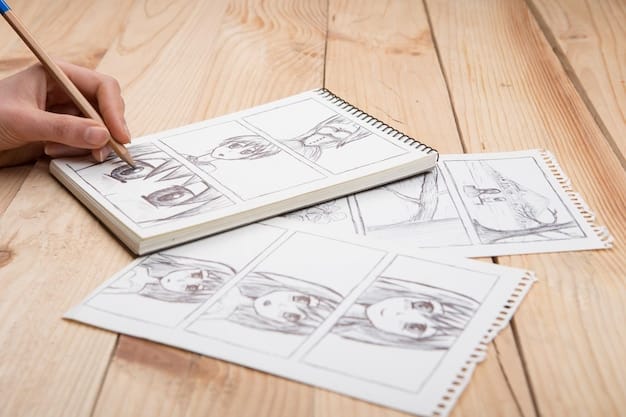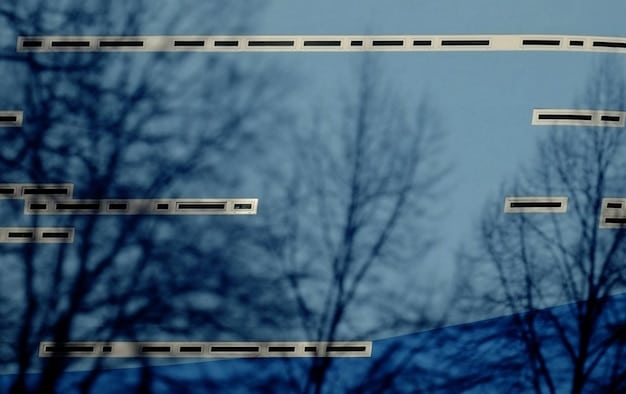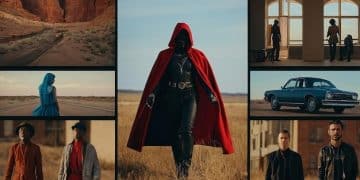Elevate Your Short Film: 3 Screenwriting Techniques

The Art of the Short: 3 Screenwriting Techniques That Will Elevate Your Story centers on crafting compelling narratives within a limited timeframe, focusing on brevity, impactful storytelling, and emotional resonance to captivate audiences.
Short films are a powerful medium for storytelling, often packing an emotional punch in just a few minutes. But how do you make the most of limited screen time? This article dives into the art of the short: 3 screenwriting techniques that will elevate your story, turning minutes into masterpieces.
Mastering The Art of the Short: 3 Screenwriting Techniques That Will Elevate Your Story
The world of short films is vibrant. It’s a place where creativity is boundless, and stories come alive in the blink of an eye. But with only a few minutes to capture an audience’s attention, screenwriters face a unique challenge. Let’s explore the essence of the art of the short: 3 screenwriting techniques that will elevate your story, ensuring your film leaves a lasting impact.
From concise storytelling to impactful character development, these techniques are the key to turning a simple idea into a cinematic gem. We’ll break down these essential elements, providing you with practical insights to transform your short film scripts.
Technique 1: Embrace Brevity and Focus
Conciseness is paramount. Every scene, every line of dialogue, must serve a purpose, driving the narrative forward with precision. This is where the art of the short: 3 screenwriting techniques that will elevate your story begins to shine.
Cut the Fat: Streamlining Your Narrative
When crafting a short film, you don’t have the luxury of meandering storylines or extensive exposition. Every scene needs to be tight and contribute directly to the central conflict.
- Identify Your Core Story: What is the one essential message you want to convey?
- Eliminate Redundancy: Are there scenes that repeat information or don’t move the plot?
- Prioritize Visual Storytelling: Show, don’t tell. Use imagery to convey emotions and information.
By focusing on the core narrative and eliminating unnecessary elements, you can create a short film that is both engaging and economical. This approach is essential for harnessing the art of the short: 3 screenwriting techniques that will elevate your story effectively.

Technique 2: Craft Compelling Characters Quickly
In a feature film, you have ample time to introduce and develop characters. In a short, you need to establish compelling characters swiftly, making them relatable and memorable in a matter of moments.
Character Arcs in Miniature: Effective Character Development
Even in a short film, a character can undergo a significant transformation. It’s about identifying the key turning points and presenting them in a concise yet impactful way, highlighting the art of the short: 3 screenwriting techniques that will elevate your story.
- Define a Clear Goal: What does your character want to achieve in this short?
- Show Their Flaws: Characters are more relatable when they have imperfections.
- Create a Moment of Change: A single event that alters their perspective or direction.
- Use Strong Dialogue: Dialogue should showcase character, not just move the plot.
Giving your character simple, clear goals will help make them relatable even within the limited screen time and will allow your audience to immerse in the art of the short: 3 screenwriting techniques that will elevate your story.
Technique 3: Leave a Lasting Impression
The ending of your short film is critical. It’s the final note, the takeaway that lingers with the audience long after the credits roll. To master the art of the short: 3 screenwriting techniques that will elevate your story, the ending must be carefully crafted.
The Power of the Unexpected: Memorable Endings
A predictable ending can undermine the emotional impact of your film. Instead, strive for an ending that surprises, challenges, or provokes thought. A key technique for mastering the art of the short: 3 screenwriting techniques that will elevate your story is a carefully crafted resolution.
- Subvert Expectations: Turn a trope on its head.
- Leave a Question Unanswered: Encourage viewers to ponder the meaning.
- End on an Image: A final, powerful visual that encapsulates the theme.
- Focus on feelings: Have your audience think about a specific emotion.
The element of surprise is key to a good short-film ending. By leaving a lasting impression, your short film will resonate with the audience long after the credits have finished which enhances the art of the short: 3 screenwriting techniques that will elevate your story.

Examples Of Incredible Short Film Screenwriting
Many films have used the above strategies to great success. With the art of the short: 3 screenwriting techniques that will elevate your story, you can write amazing shorts and maybe even win some awards!
“Lights Out” (2013)
Directed by David F. Sandberg, “Lights Out” is a horror short film that masterfully uses brevity to create a chilling experience. The film focuses on a woman who discovers a terrifying presence that only exists when the lights are turned off. “Lights Out” is a great example of the art of the short: 3 screenwriting techniques that will elevate your story due to it’s shocking twist and simple story.
The success of “Lights Out” lies in its efficient storytelling and effective use of suspense. Sandberg relies on visual cues and minimal dialogue to convey the horror, making every second count. The short’s impact led to a feature-length adaptation, proving the power of a well-executed concept. With the art of the short: 3 screenwriting techniques that will elevate your story you might have a similar level of success!
“Bambi Meets Godzilla” (1969)
Directed by Marv Newland, “Bambi Meets Godzilla” is an animated short film known for its abrupt and comedic ending. The film starts innocently with Bambi frolicking in a meadow, only to be suddenly crushed by Godzilla’s giant foot. This is a true example of the art of the short: 3 screenwriting techniques that will elevate your story.
The film’s humor comes from its unexpected juxtaposition of innocence and destruction, leaving the audience with a memorable and shocking finale. “Bambi Meets Godzilla” demonstrates how a simple idea can be elevated through clever execution and a surprise twist, which is why it stands out as a notable example in short film history and why you should focus on the art of the short: 3 screenwriting techniques that will elevate your story.
“The Neighbors’ Window” (2019)
“The Neighbors’ Window,” directed by Marshall Curry, is a compelling short film that explores themes of voyeurism, regret, and the illusion of perfection. Inspired by a true story, the film follows a couple who become fixated on watching their carefree and adventurous neighbors across the street. This exploration is truly the art of the short: 3 screenwriting techniques that will elevate your story.
It won the Academy Award for Best Live Action Short Film, and its success lies in its ability to tell a complete and emotionally resonant story within a short timeframe. The characters are well-developed, and the narrative is both engaging and thought-provoking. As if all of that wasn’t enough, the film is a stellar example of how to utilize the art of the short: 3 screenwriting techniques that will elevate your story.
In Summary: It’s All About The Script
Creating a compelling short film is about more than just visuals. By following the art of the short: 3 screenwriting techniques that will elevate your story, you are one step closer to creating masterpieces.
| Key Point | Brief Description |
|---|---|
| 🎬 Brevity | Every moment must directly further the narrative. |
| 👤 Characters | Quickly establish empathy through flaws and clear goals. |
| 🤯 Endings | Leave the audience pondering with unexpected twists. |
| 🏆 Awards | High-level screenwriting may help you win great accolades. |
Frequently Asked Questions
Brevity is key. Every scene and line of dialogue should serve a purpose, driving the narrative forward efficiently. Focus on what truly matters to the story.
Develop your characters quickly by giving them clear goals and showing their flaws. Creating small character arcs that your audience can grasp will help them leave an impact.
Craft unexpected endings that leave the audience thinking. Subvert expectations, leave questions unanswered, or end on a powerful final image, to stay in your audience’s hearts.
Assess the purpose of each scene and only include information that moves the plot forward. Cut the fat: eliminate redundancy and prioritize visual storytelling over exposition.
Yes, but focus on key turning points presented concisely. A single event that alters their perspective can lead to a satisfying arc.
Conclusion
In summary, mastering the art of the short: 3 screenwriting techniques that will elevate your story involves embracing brevity, crafting compelling characters quickly, and leaving a lasting impression with a powerful ending. By focusing on these elements, you can transform your short film scripts into cinematic gems.





